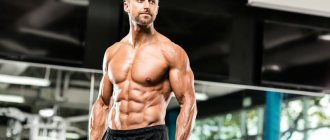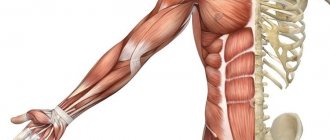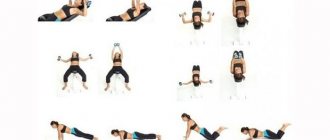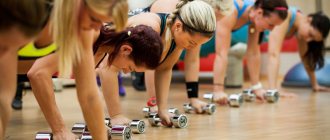Classic powerlifting (powerlifting) is a discipline of weightlifting, which is based on the principle of overcoming the maximum weight allowed for a competitor. Powerlifting requires exhausting training, a special diet, psychological resistance to possible and dangerous injuries, as well as superhuman dedication. Powerlifting has another name: powerlifting.
This is characterized by the fact that three basic approaches are used as competitions: deep squats, bench press, and deadlift. Their total coefficient determines their position in the table.
Powerlifting Foundation
A competitor seeking to win must demonstrate the highest possible potential during the performance of each of these exercises, using the entire technical arsenal. Squats, presses and barbell rows involve several groups of joints and almost all the athlete’s muscle fibers. This workout is recommended for beginners in order to gain weight and develop strength endurance. The desired results will appear if you perform approaches every other day, depending on how you feel.
On a note!
The powerlifting complex is also used in bodybuilding, but the emphasis there is on muscle volume. On the contrary, the power of an athlete is the most important indicator in powerlifting. The photos below show a representative of this discipline .
The workouts are structured as follows: the strongman performs approaches with the maximum possible load once or twice. Rest is determined by individual well-being and varies up to 10 minutes. Since the athlete's skeleton and muscles are subject to excessive stress, prolonged recovery is necessary.
At official powerlifting competitions, the demonstrated performance of competitors of the same weight is compared. The score is summed up from the maximum ratios in the bench press, squat and deadlift. If the athletes take the same weight, the one whose body weight is less wins.
Powerlifting competition
Beginners are always interested in whether they will be able to demonstrate results somewhere. They will be satisfied: international competitions are held in this sport.
Participants are divided by weight categories and age ; teenagers take part in competitions from the age of 12. Upon reaching 23 years of age, the participant is considered an adult and competes with adult opponents.
If two people win during the competition, then the prize place is given to the one who weighs less (taking into account one weight category for the participants).
A girl at a powerlifting competition prepares for the bench press
The history of powerlifting
The discipline originates from exercises used by professional weightlifters to improve their basic performance levels. Unlike the modern triple concept, strongmen included lifting the biceps brachii from different positions in their training.
Orthodox weightlifting called such approaches “strange,” but in the West they gained particular popularity in the mid-20th century. At the same time, competitions began to arise, and 10–15 years later, powerlifting was born. In the 60s, the rules for holding competitions were classified, which are still held at the world level.
On a note!
Independently of American powerlifting, powerlifting developed in the British Isles. The competition mode included: biceps lift, bench press, deep squats with a load. The competition was called Strength Set and took place in the late 50s.
In 1964, the first US national competition was held, in which the three main exercises were already regulated by law. In 1972, the International Powerlifting Federation was organized, and soon the first world championship was held. In the early 80s, girls took part in the competition. In addition to the IPF, similar organizations have emerged on the powerlifting sports map to promote the sport. Their number is constantly growing, but the first Federation (IPF) remains the most popular.
Powerlifting in the USSR
Powerlifting was not encouraged in the country, as were martial arts. Instead of the Western term powerlifting, the phrase athletic gymnastics was used. Soviet discipline differed from American discipline and was combined with bodybuilding. A strongman from the USSR had to demonstrate not only excellent results in approaches, but also look like an ancient Greek athlete - aesthetically built.
In the 60s, the state allowed the publication of magazines, on the pages of which anyone could find information about bodybuilding. A decade later, amateur competitions began to be held. Only in the 80s of the 20th century did citizens of the USSR see the first official competitions with established rules. Deadlift was removed from the list, calling it a “bourgeois” reference. Participants had to compete in jumping, pull-ups, etc. Only in 1987 was powerlifting officially recognized as a sport in the Soviet Union. At the same time, a committee for this discipline was created, and Olympic champion Yu. Vlasov became its head.
Interesting!
At the end of the 80s, a meeting between Soviet and American athletes took place. Both sides were surprised by the performance and equipment of each other. Thus, Western athletes paid great attention to safety, while Soviet bodybuilders were much more technical in their performance, but took risks with heavy loads.
Current trends
Powerlifting is the main component of powerlifting in modern times . Each exercise is given three attempts. In America and Europe, competitions in this sport are very popular; independent leagues are organized with their own rules. Some associations are heading towards creating vibrant performances with non-trivial equipment and artistic behavior of athletes, while others adhere to the classic version of the performance.
Exercise Analysis
Squats with a barbell, bench press and deadlifts are used in the training of many athletes (bodybuilders, weightlifters, mixed martial artists). However, performing on the platform is fundamentally different from how it is done in the training process. The IPF has defined the following requirements:
- The athlete performs approaches strictly at the command of the judges. If the rules are violated, the athlete's result is canceled.
- The squat should be deep, that is, the bodybuilder’s hip joint falls below the knee.
- If the bar falls out of the hands, the participant receives a penalty.
- The judges strictly monitor the position of the projectile on the back.
- The barbell press is carried out in three commands: “Start! Press! Rack!" After the first, it is necessary for the projectile to touch the chest, after the second, the main movement occurs, and the last instruction is focused on returning the bar to the rack.
- When pressing, it is forbidden to lift the heels, head, buttocks and shoulder blades from the surface, or change the position of the legs.
- The athlete himself chooses what grip width he will use.
- When performing a deadlift, it is prohibited to support the apparatus with your hips.
- The start of the lift does not require instructions from the judge, but the lowering of the bar requires only a command.
- The width of the legs and grip is an individual matter for each athlete.
Powerlifting for women: what's the best way to start?
Ladies, it's time to ditch the lightweight plastic dumbbells and grab some iron. If you're thinking about training for powerlifting, here are some tips to help you find your way.
Author: Laura Hughes, personal trainer, sports rehabilitation therapist.
If you haven't noticed, powerlifting isn't just for men these days. More and more women are realizing that becoming better, stronger, more powerful and more confident should not be the job of just men.
The numbers confirm this. In the United States alone, the number of female powerlifters has doubled since 2015, and that's only for those women who compete in powerlifting, not the countless women who train in the style of powerlifting without declaring themselves to the world that they are powerlifters.
This step-by-step guide will help you take your first steps in this strength sport.
Find a professional trainer and training program
If you're new to the gym or an aspiring powerlifter, start by finding a training program and coach. Online coaching is becoming more and more available, but you're better off asking around and seeing if you can find someone locally who can coach you face-to-face, explaining all the ins and outs without leaving your side.
Once you're back on your feet, you can move on to online training programs or workouts, and maybe even start your own women's powerlifting group to train together.
Master basic exercises
Learn proper form and technique for the three main strength exercises: the squat, bench press, and deadlift. Mastering these exercises requires experience, so you should definitely find a professional trainer rather than trying to master these movements on your own.
Plan your activities
Just like you plan your day, week, etc., set a specific time when you will go to the gym to work out. As you probably already know, if you don't set aside time to do something, you'll find something else to fill that time—and it probably won't be as challenging as practicing powerlifting.
Schedule training—and rest—time so you can work slowly but surely to strengthen your powerlifting skills. You will be lifting quite heavy weights as part of these workouts. This means you need more rest than your typical bodybuilding and fitness training routine.
Warming up and stretching are also an important part of powerlifting training. Make sure you make this part of your workout, including on recovery days.
Attend a local powerlifting competition
It's fun and exciting to watch people lift heavy weights and break records. It can also be very motivating and a great way to network with other women new to the sport as well as professionals. There is no better way to learn how a meet is run, how lifters prepare for competition, what they do in the lead-up to an event, and how judges make their decisions.
Many powerlifting events are streamed live on powerliftingwatch.com and YouTube if you can't attend the meet in person or there isn't one in your area.
Set realistic goals for yourself
First, your coach can help you set reasonable and achievable goals. As you progress in the sport, they will help you determine the data and rankings for each weight class and category you fall into.
Bookmark powerliftingwatch.com to get started with powerlifting.
Try yourself in your first competition
For your very first event, start with a local sporting competition or push-pull event (press and deadlift). These types of gatherings are usually relaxed, fun events that won't overwhelm you too much. This type of competition should be held at least 8-12 weeks apart to give you enough time to prepare.
Before you begin preparing for a particular event, make sure you understand the rules and regulations of the federation sponsoring the event. Your coach can help you with this too!
Start training
You can take all your ducks to the pond, but that's not enough, you have to push them into the water so they learn to swim! Once you've found a coach, a training program, and prepared your workout clothes and equipment, it's time to head to the gym and start training! And once you get there, start training vigorously and consistently!
Sport equipment
Supportive equipment is considered mandatory in all official competitions. It is intended to protect the participant from serious injury. In addition, the rigid fabric of the equipment allows for improved results in exercises. Powerlifter clothing includes:
- Elastic tights and T-shirt with sleeves.
- a fairly wide belt used in weightlifting.
- Shin guards, soft slippers and knee pads for deadlifting. · Unique squat bars.
- Weightlifting wristbands to remove excess sweat from the face.
The benefits and harms of exercise
Powerlifting is a sport that carries a high risk of serious injury. The most important condition for a long life in powerlifting is excellent physical preparation of the bodybuilder. If an athlete has unprepared joints and ligaments and tired muscles, there is a danger of ending up in the hospital for a long time. A healthy diet and proper training will prolong the life of an athlete in this dangerous sport. The benefits of powerlifting are as follows:
- Sleep, appetite and immunity are normalized.
- Increases endurance and improves blood circulation.
- An athlete's muscles accumulate great strength.
Important!
Positive health results in powerlifting are achieved exclusively under the strict supervision of coaches and doctors, who diligently ensure that the ward follows a sleep, eating and training schedule. In this matter, every parameter is important, be it weight, gender, age or general condition.
Improper execution of exercises will cause great harm . Athletes' spinal discs often become dislodged and herniated. Some athletes begin to suffer from pathologies of the heart, muscles, tendons and joints, abusing powerlifting training. There is no opportunity for children and adolescents to engage in this traumatic discipline, since excessive loads on the growing skeleton provoke irreversible curvature of the spine.
What is powerlifting for women?
Girls who engage in this sport quickly lose weight, strengthen their own muscles and increase self-esteem . It used to be a common belief that powerlifting makes a woman masculine. It is now known that the body of expectant mothers has little testosterone hormone, so the growth of huge muscles is almost impossible.
Training in powerlifting is aimed at developing relief and increasing power. Girls who do powerlifting every day remain graceful and slim if they do not use steroids and hormonal drugs.
On a note!
Proper powerlifting training will not prevent a girl from giving birth to a healthy child. On the contrary, exercises will strengthen the abdominal cavity and normalize hormonal levels, this will allow the fetus to develop harmoniously in the mother's womb.
Features of men's powerlifting
Among men involved in powerlifting, it is also rare to find those who can boast of an amazing figure. The main thing is not muscle relief and figure, but the weight that a man can lift. Perfectly performed exercises and technique are also not important. What matters is how many muscles a man uses to overcome his own results.
The training includes exercises from powerlifting and auxiliary, general strengthening exercises. There are no exercises in powerlifting aimed at “drying” or making the muscle relief more pronounced.
People who are not good at bodybuilding often go into powerlifting. This may be due to the inability to perform exercises cleanly (and in bodybuilding, technique is an important condition) or to unexpressed muscles (individual characteristics of the body).
Features of men's powerlifting










